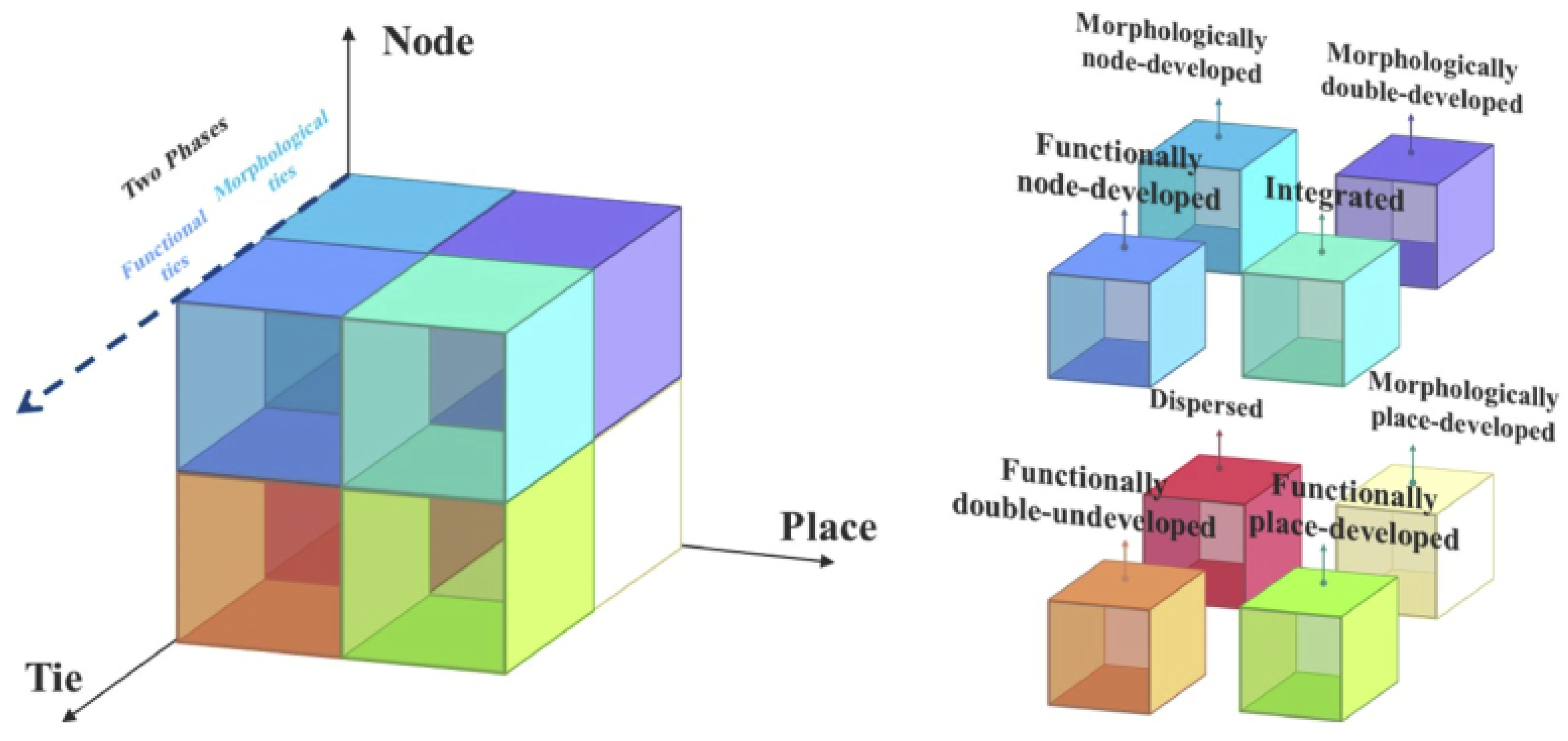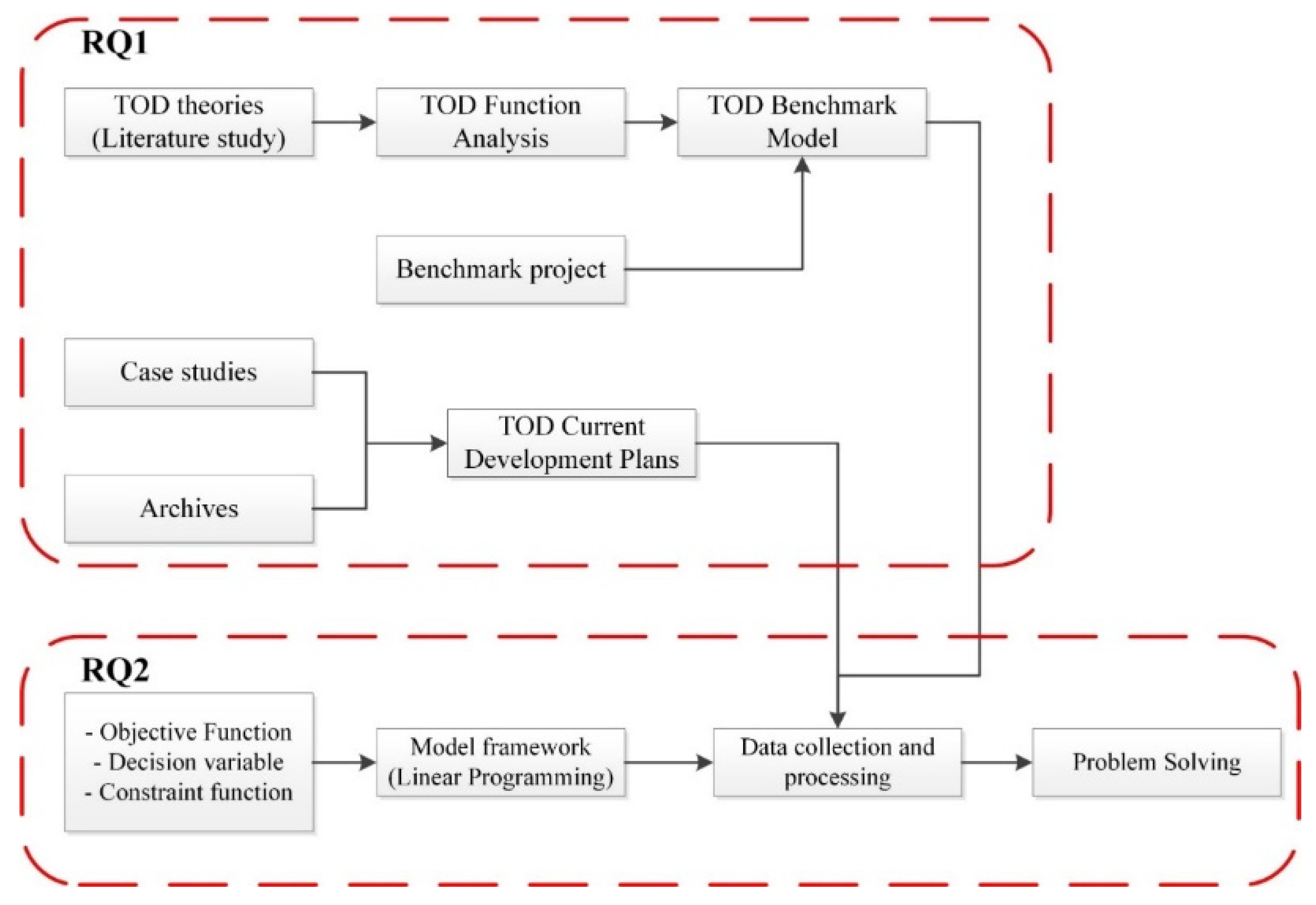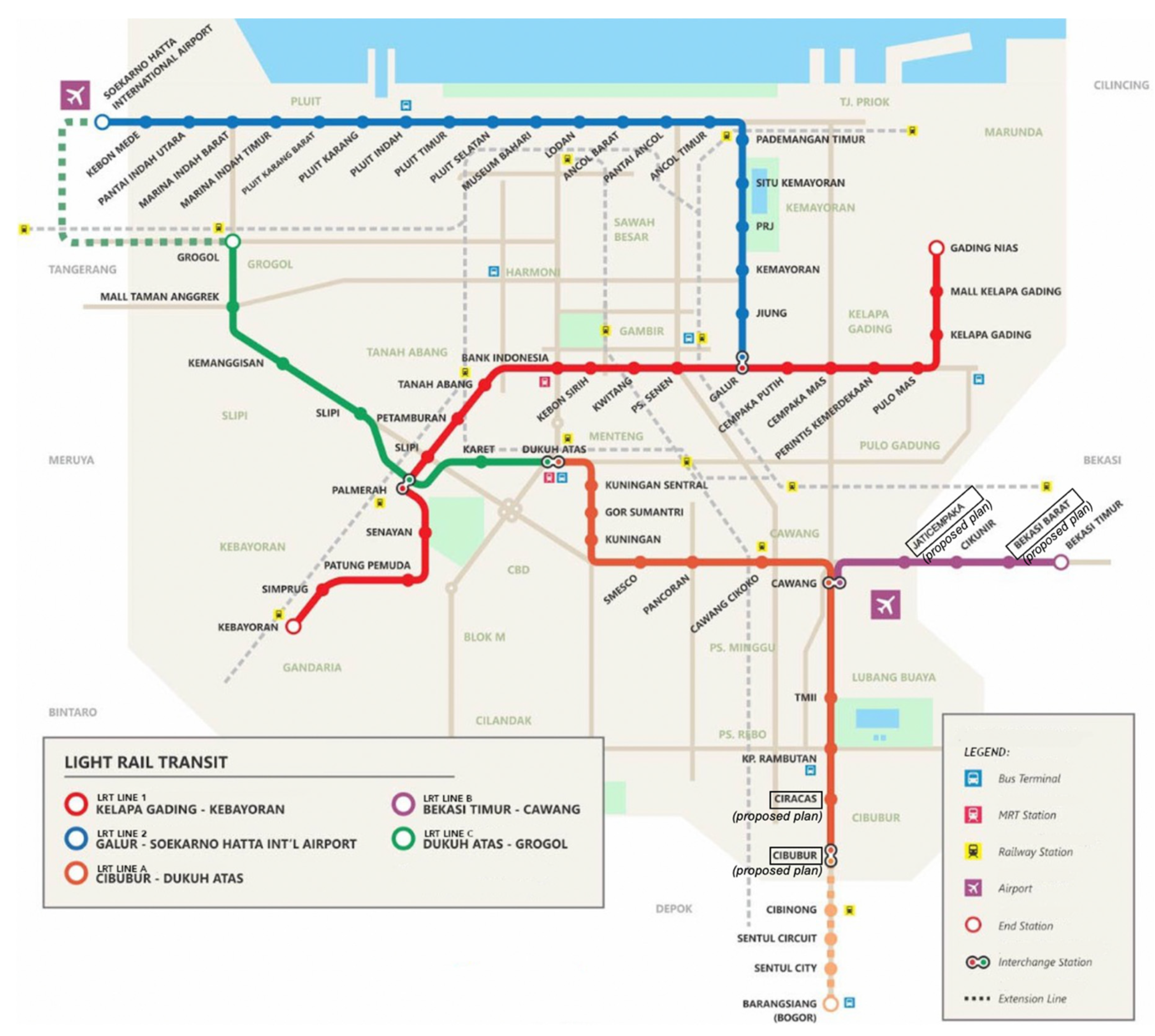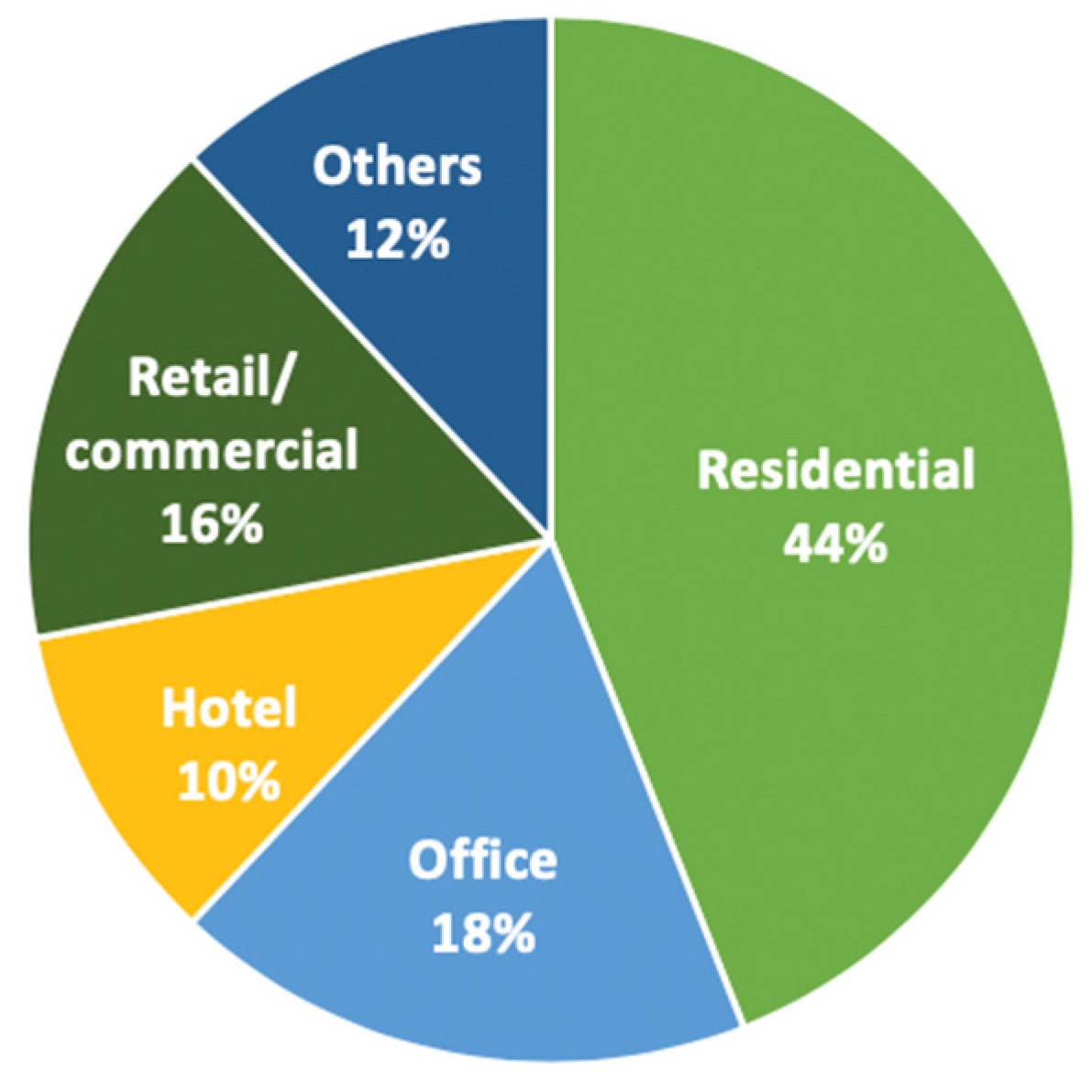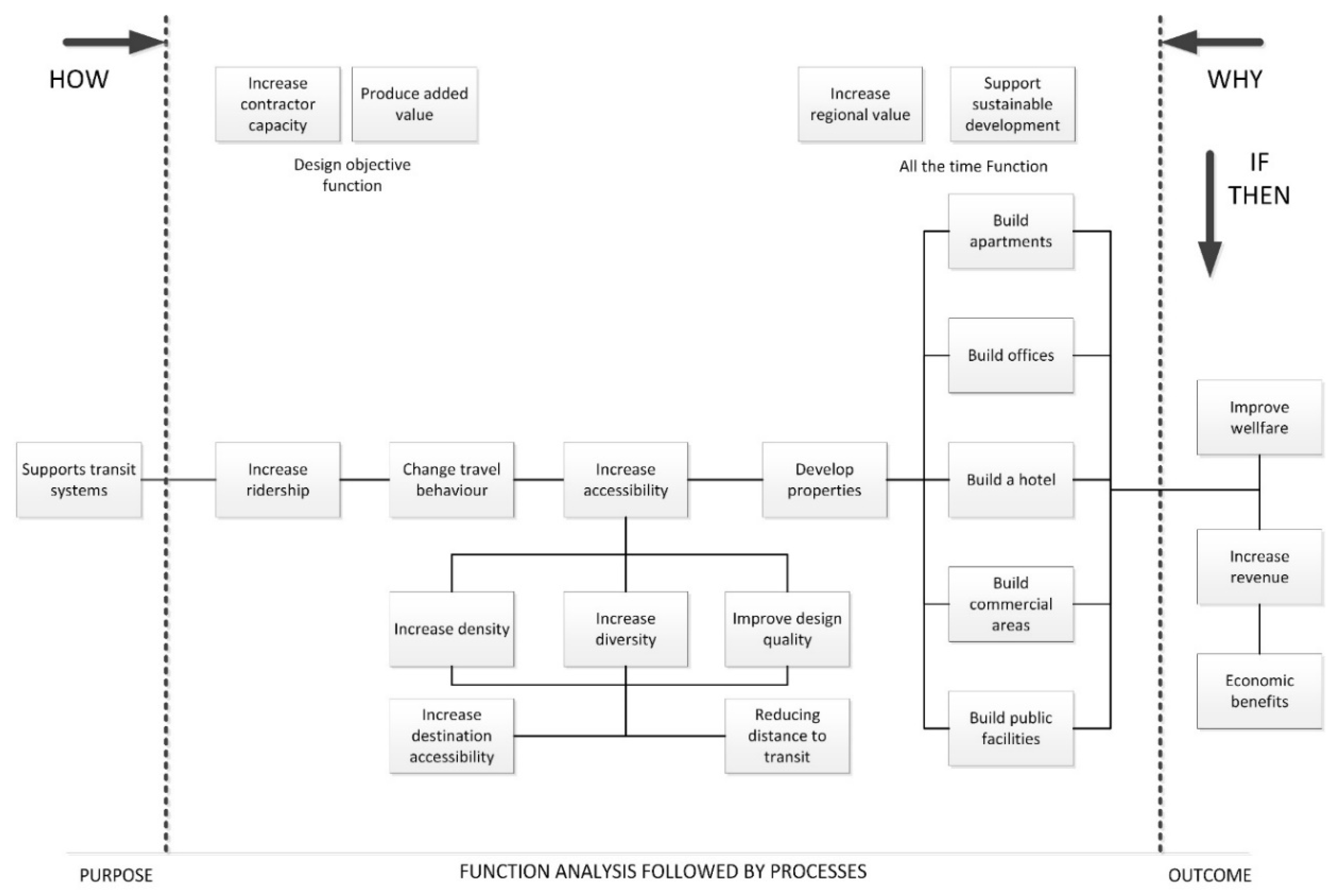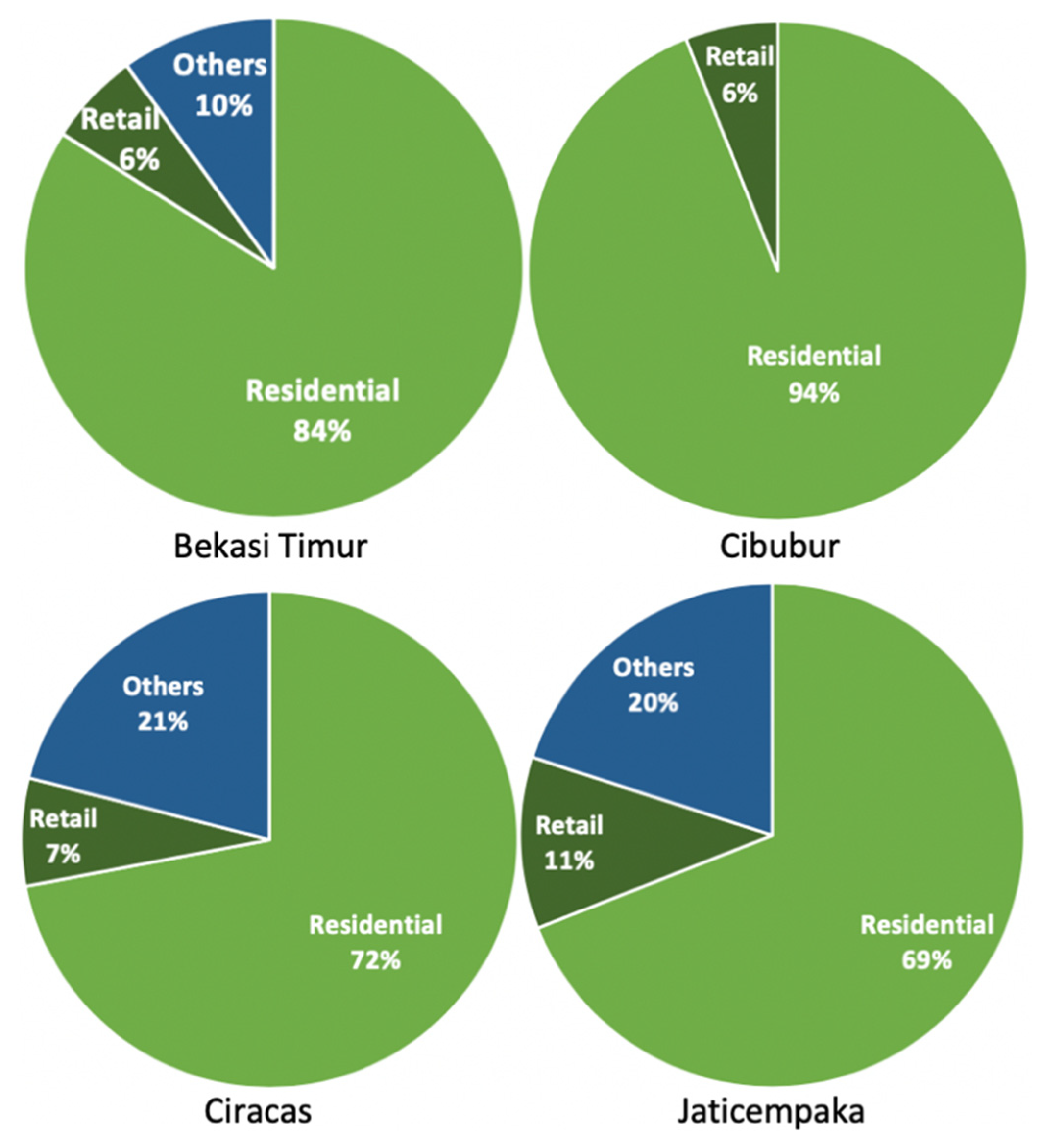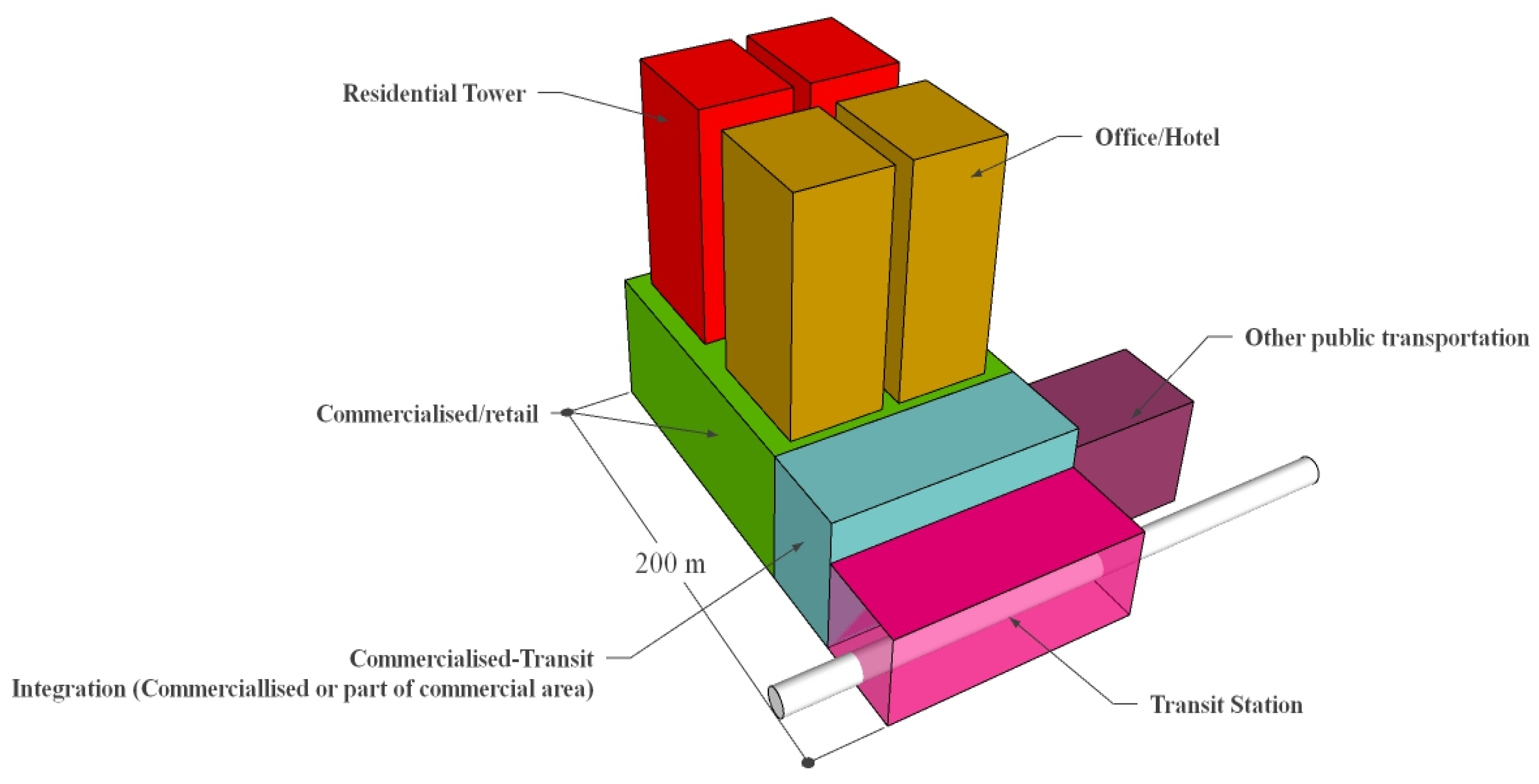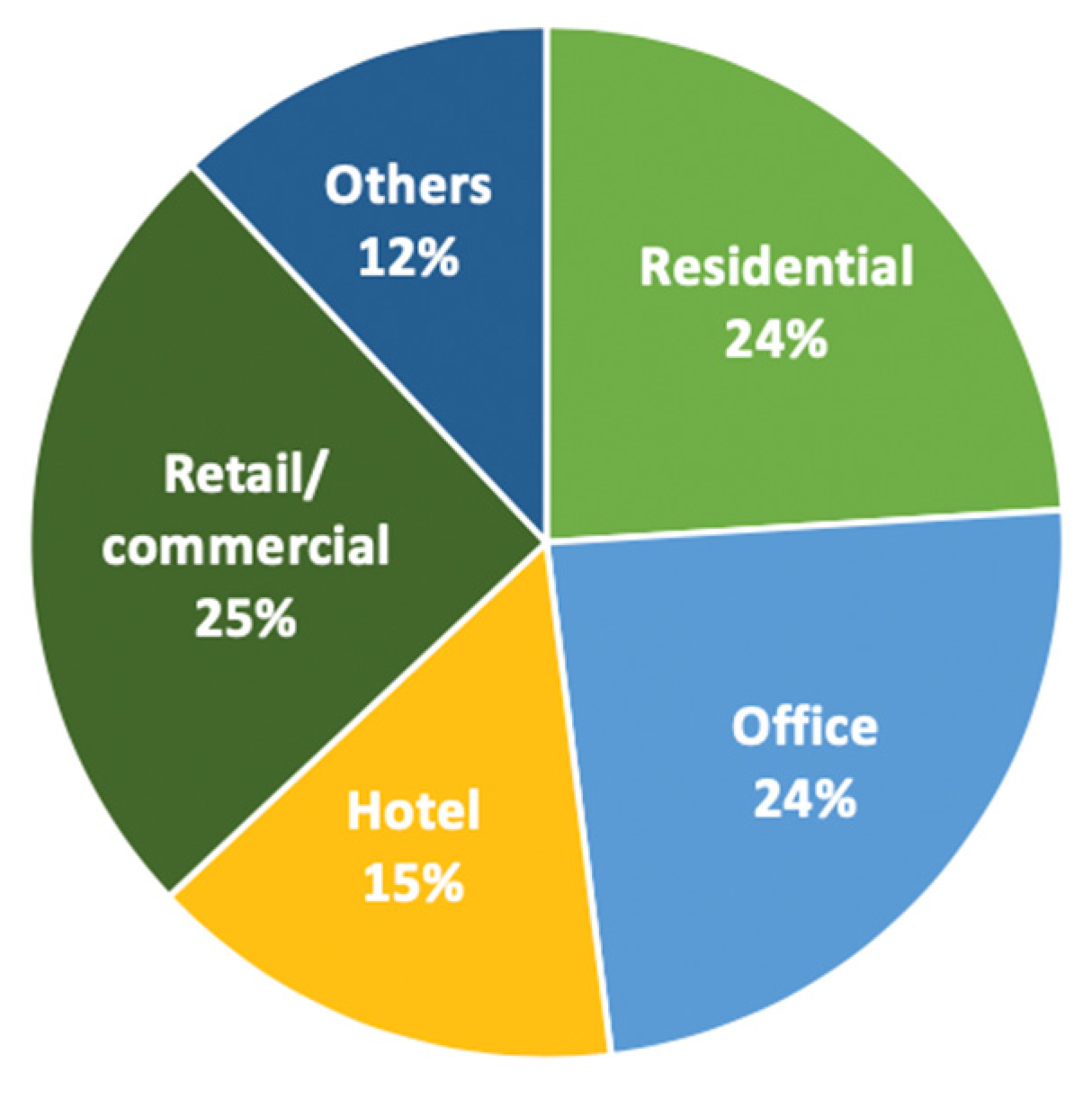4.1. Benchmark TOD Models
The guidelines in this benchmarking process consisted of TOD developments in three countries, which included Union Square in the Kowloon area of Hong Kong, Namba Parks near Sekai Station in Osaka, Japan and D’Cube City in Seoul, South Korea. Regarding the design and destination accessibility, Union Square seemed to be developed with the most efficient integration in which the residential, office and other buildings sat on the top of the commercial podium that houses the Kowloon station; besides, its multifunction areas located at the distance of approximately 200 m from the transit station encourage dwellers to walk in as easy and comfortable access is provided. Namba Parks, which was connected to the transit station through direct pedestrian access, was planned as an attraction so that people could visit and wander around the TOD and its signature natural terraced pedestrian-oriented design as a tourist destination. The visitors from outside the neighborhood were anticipated with the hotel built in the TOD. Moreover, since it is confined within a 400-m radius from a transit station, Namba Parks also allows pedestrians to walk through the buildings that make the distance to transit closer. On the other hand, D’Cube City was designed to be a live, work, play and stay destination in Seoul with a vibrant pedestrian-oriented district and direct access to the Shindorim Station, expected to attract tourists with all the public services within walking distance.
The benchmark model considers three square area metrics consisting of the building coverage ratio (BCR), floor aspect ratio (FAR) and the proportion of floor areas. Although the literature showed that other variables existed to create the TOD model (number of workers, property sales, employment ratio or economic landscape) [
65,
66], square area metrics was believed to be the core measurement to expose the TOD density and to evaluate the property and transit relationship. These three square area metrics were determined using properties mean values from existing the TODs in Union Square, Namba Parks, and D’Cube City [
61] in order to make a comparison with the existing TOD plans in Indonesia.
The land use mix found in the benchmarking model was residential areas, offices, commercial/retail areas and hotels. This finding confirmed the TOD planning that has been conducted in Denver, United States, where most land use mix may consist of but not be limited to office, residential, retail, entertainment and civic uses depending on their typology [
67]. The composition of land use allocation at each location is shown in
Table 2, with the range being the minimum and maximum percentage floor area usage. The benchmark model has a BCR of 92% and a FAR of 7.29, with the floor area usage summarized in
Figure 4.
To achieve the objective of the research, this study adopted the technical FAST diagram produced from function analysis by determining the study problem, which was the benchmark TOD. This was followed by identifying its function (which was based on the theory from the literature study).
Figure 5 shows the FAST Diagram of TOD with a supporting transit system as the purpose of the project while improving welfare and increasing revenue with economic benefits being the outcome. TOD would mean nothing without a change in travel behavior, increased accessibility and developed properties, which are all critical aspects of its function (with increased ridership being the main function).
4.3. Ridership TOD Model
The modal split value for commuting trips was obtained from a benchmark study from Tokyo, with rail transit acting as the backbone mode of travel activity. On the other hand, non-commuting trips were retrieved from a previous study conducted by Lund et al. [
64].
The transit ridership optimization approach derived from the required per person space requirement in a building has been applied by Hendrigan and Newman [
68] in modeling the daily trips to estimate the capacity of transit mode in providing services for a dense, walkable and mixed-use area in Perth, Australia. Their research resulted in an estimation model of additional real estate yields obtained from a function of parking lot reduction and high transit mode capacity. The modal split of rail transit was obtained from a benchmarking study to the successful TOD areas in which rail transit is the main transit mode used in that city, such as in Tokyo and California; hence Jakarta was not selected since it could not be included in that category yet. The rail transit modal split was estimated by combining the modal split value of Tokyo for commuting trips (trips made from home to work which can include office, hotel or commercial area) and the findings from a TOD research in California conducted by Lund et al. [
64]. The modal split value for the commuting trip was 73%, which was the maximum modal split value that had been achieved in Tokyo (see
Table 4). Therefore, the same modal split value was used for apartment and office areas, considering that both were the main elements of the commuting trip end.
In hotel and commercial uses, there are two elements of trips, namely commuting trips done by workers who work in hotels and commercial retail and non-commuting trips done by hotel guests with an average rail modal split value of 44.17% (see
Table 5) and retail visitors, the average rail modal split value of which is 12.58%. The rail modal split values for hotel and commercial areas were determined by taking the average rail modal split values of commuting trips and non-commuting trips, hence the modal split values for the hotel and commercial areas were 58.6% and 42.8% respectively.
Therefore, the value of the required input parameters (see Equation (1)), i.e., the transit trip generation rates, was estimated by multiplying the rail transit modal split and the required space area per person in a building plan [
72,
73] for the aforementioned purposes (
Table 6).
The mandatory constraint related to the maximum gross floor area (GFA) was permitted to be built at the site. It was the result of the multiplication of the floor-area ratio (FAR) and the land site. In other words, the mixed-use development gross floor area should not exceed those figures. The conditional constraints were related to restriction on developing particular uses, such as the maximum/minimum GFA of commercial/residential areas, and other factors expressed in values or percentages. The last constraint was on non-negativity, which inhibited the model from generating the negative value of the decision variables. These were defined in accordance with the benchmark study (see
Table 2). Based on the above explanation, the TOD optimization model to maximize ridership is presented as follows:
The above model was used to resolve the optimization problem in TOD planning on a land parcel of four LRT station areas. The first process evaluated ridership from the existing development plans, with the value of each gross floor area added into the objective functional equation (Equation (4)) to obtain the estimated values of ridership, as shown in
Table 7.
Using the same method, the values of the ridership of Jakarta TOD with the benchmark-based land use allocation can be seen in
Table 8.
The next step was to optimize the design using the linear programming optimization approach. Bekasi Timur LRT station area was an example of the application model. The TOD of Bekasi Timur was planned to be built on 50,000 m
2 of land, with a maximum GFA of 178,100 m
2. Based on the case study above, the linear programming process was executed. The Simplex method using the Solver parameter from the spreadsheet application was utilized.
Table 9 shows the optimum TOD design from a linear programming-based optimization model using a typical benchmarking design. Based on
Table 8, the ridership estimation of the Bekasi Timur LRT station with benchmark-based land use allocation was 15,921 trips per day, while the optimized design generated 1407 additional trips (from 15,921 to 17,328). This increase was a result of the optimization space taken from the residential proportion. Residential space was reduced by 20%, to be allocated to retail, hotel and office development based on the trip generation rates and the defined constraints.
The objective function showed that the highest rate of transit trip boarding came from office workers. Several studies revealed that workplace development near a station is the main determinant of transit ridership. The result of a study conducted by Kwoka et al. [
74] in Denver, Colorado, suggested that locating workplaces closer to transit is more effective in encouraging non-car workers to commute than residential places. Evans and Pratt [
75] reported that every 1000 feet away from stations on the Washington Metro lines, the reduction in transit mode share regarding the office location was 58% higher than that of housing. Recent research on ridership-determinant factors of the Shanghai rail transit system has revealed that employment within 500 m of a station is the dominant factor in increasing rail passenger volume, which is, therefore, the key component of TOD planning [
76].
The potential ridership using the land use allocation obtained from the benchmark study (
Table 8) and the optimized design of the Jakarta TOD (
Table 10) were then compared with the ridership of the existing Jakarta TOD plan (
Table 7). The existing planned design of the Jakarta TOD comprised residential development as its major land use, with other non-residential developments were allocated less than 40%.
Table 11 shows the additional rate of ridership in each case study resulting from the evaluation of the benchmark design and optimization process.
The optimized design was capable of boosting the LRT ridership up to 55% in Ciracas, 51% in Jaticempaka and 36% in Bekasi Timur, while the lowest ridership optimization took place in Cibubur. This optimized mixed-use allocation for the Jakarta TOD areas, which comprised 24% residential, 25% retail, 15% hotel, 24% office and 12% others, as shown in
Figure 8, will be able to generate maximum ridership for the Jakarta LRT.
Comparing the maximized ridership generated by the optimized TOD design with the existing TOD design, it can be seen that the ridership in Ciracas was boosted by 9931 passengers daily, 5500 passengers daily in Jaticempaka, 4615 passengers daily in Bekasi Timur and 2854 passengers daily in Cibubur. This was in line with the finding of the study by Cervero and Murakami [
11] investigating the transit ridership of the TOD in Hong Kong, which pursued a transit value capture to fund the railway investment through the integration of the rail transit and urban development named the ‘R+P’ program that showed that a transit-oriented design of a rail station yields benefits not only to the real estate prices but also to the transit ridership. The mixed-land use, design integration and pedestrian-oriented walking environment as the key elements of transit-oriented development evidently have a positive impact on ridership at the Hong Kong’s rail transit stations.
The finding of this study supported the TOD principle that well designed TOD with land use diversity will help transit service to sustainably finance its operation through the farebox generated by maximum ridership. Moreover, property development designed with consideration to its accessibility to transit can also be benefited in the form of a property price upgrade. Moreover, universal accessibility addresses the issue on social equity by making the safe and affordable mode of transport available for everyone, opening equal access to basic needs such as education, health and employment opportunity.
Well planned integrated transit and its diverse land development are the most effective way to achieve sustainability in urban development, as they help growing cities improve their economic development, ecological sustainability and social equity by providing inclusive transport and a livable environment accessible for all. Therefore, in order to achieve sustainable urban development, this study attempted to address this issue by formulating optimum densities around transit areas by putting in close proximity all functions including the residential, retail/commercial, office and other areas (parking spaces and open places) integrated into the concept of “live-work-play-stay-others” in the development of a TOD project which can generate more ridership for the rail transit modal split.
